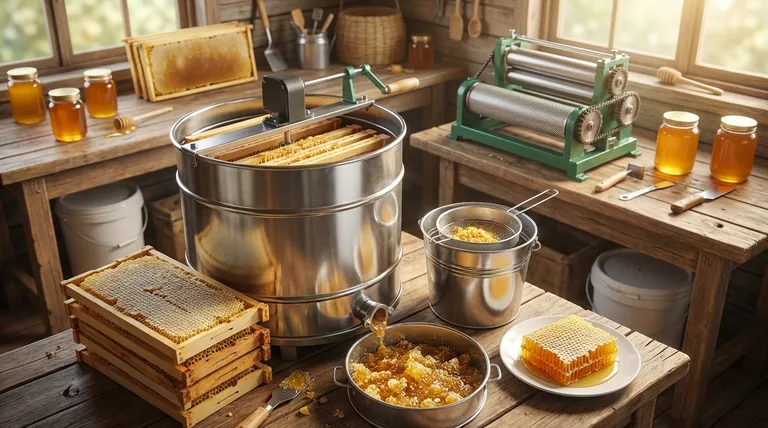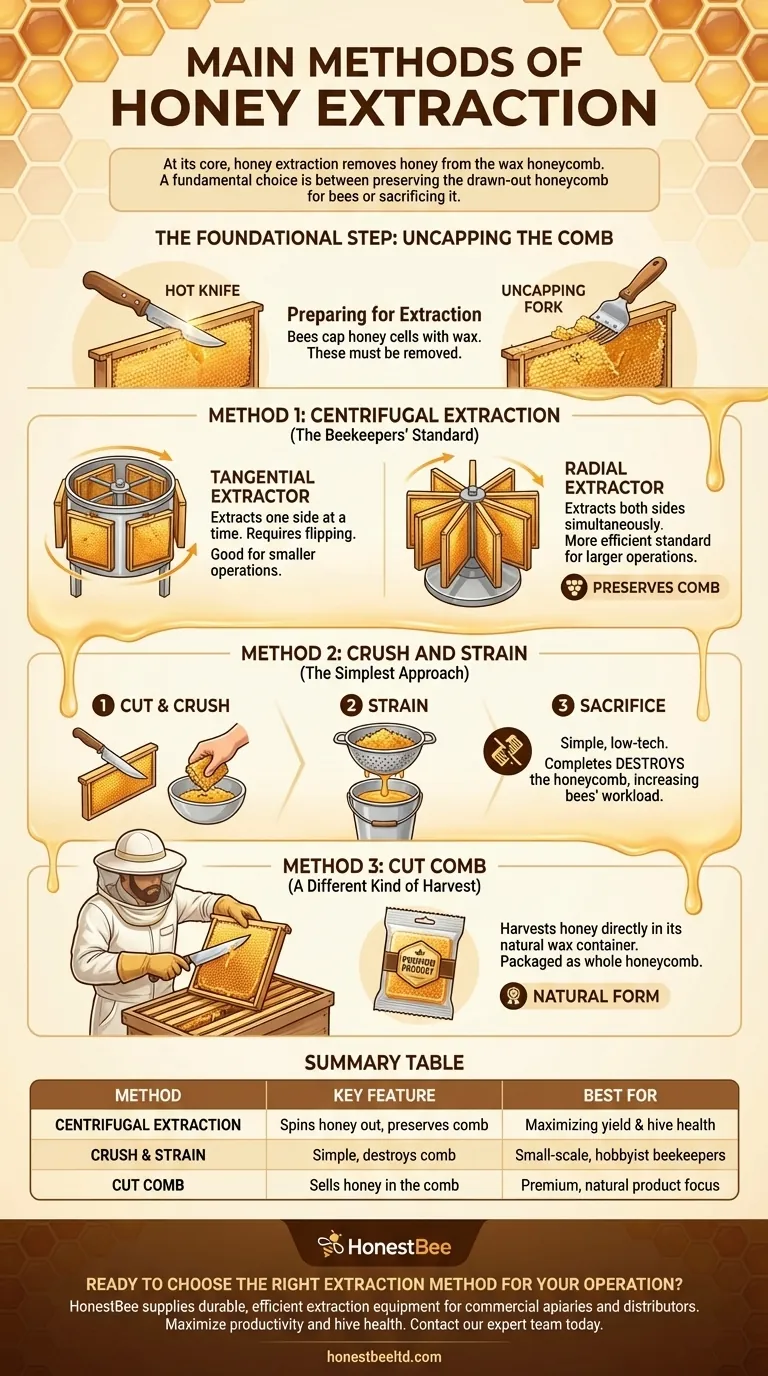At its core, honey extraction involves removing honey from the wax honeycomb. The three primary methods are centrifugal extraction, which spins honey out of the comb; the crush and strain method, which destroys the comb to release the honey; and the cut comb method, where the honeycomb is packaged and sold as a whole.
The fundamental choice in honey extraction is not just about equipment, but about a core philosophy: whether to preserve the drawn-out honeycomb for the bees to reuse or to sacrifice it in the process. This decision directly impacts your apiary's efficiency and the bees' workload.

The Foundational Step: Uncapping the Comb
Preparing for Extraction
Before any liquid honey can be extracted, the wax caps that seal each cell of honey must be removed. Bees cap honey cells with fresh beeswax once the honey has been dehydrated to the correct moisture content (around 18%).
Essential Uncapping Tools
Beekeepers typically use a hot knife or an uncapping fork. A hot knife is electrically heated and slices off the top layer of wax cleanly. An uncapping fork is a simpler tool used to scratch open the cappings, which is effective but can be more time-consuming.
Method 1: Centrifugal Extraction (The Beekeepers' Standard)
How it Works
This method uses centrifugal force to sling honey out of the comb cells without damaging the comb itself. Frames are placed inside a drum-like machine called a honey extractor, which is then spun either manually with a crank or with a motor.
Tangential Extractors
In a tangential extractor, the frames are positioned with one side of the comb facing the outer wall of the drum. This extracts honey from one side at a time, requiring the beekeeper to stop, flip the frames, and spin again to empty the other side. This style is common for smaller, hobbyist operations.
Radial Extractors
A radial extractor positions the frames vertically, like spokes in a wheel. As it spins, honey is extracted from both sides of the comb simultaneously. This is far more efficient and is the standard for beekeepers with more than a few hives.
Method 2: Crush and Strain (The Simplest Approach)
How it Works
This is the most low-tech method. The beekeeper cuts the entire honeycomb out of the frame, crushes it to break open all the wax cells, and places the mixture in a strainer or colander over a bucket. Gravity slowly pulls the liquid honey down, leaving the beeswax behind.
The Major Advantage: Simplicity
The crush and strain method requires no specialized or expensive equipment beyond basic kitchen tools like buckets and strainers. This makes it highly accessible for first-time beekeepers.
The Critical Disadvantage: Sacrificing the Comb
The primary drawback is that this method completely destroys the honeycomb. Bees expend a tremendous amount of energy and resources to build this wax structure, and destroying it forces them to start over from scratch, significantly reducing their potential honey production for the next season.
Method 3: Cut Comb (A Different Kind of Harvest)
How it Works
Instead of extracting the honey, this method involves harvesting it directly in its natural wax container. The beekeeper simply uses a sharp knife to cut clean, uniform sections of sealed honeycomb directly from the frame.
The Final Product
These sections are then packaged and sold as cut comb honey. This is a premium product that many consumers value for its raw, unprocessed nature. It is less a method of extraction and more a method of preparation.
Understanding the Trade-offs
Equipment Cost vs. Apiary Health
A centrifugal extractor is a significant investment, but it preserves the bees' most valuable resource: their drawn comb. The crush and strain method is free but comes at a high biological cost to the colony.
Hygiene and Contamination
Regardless of the method, honey is a food product and must be handled with care. Ensure your workspace, hands, and all equipment are impeccably clean to avoid contamination. After extraction, honey is typically strained to remove wax particles and other debris before bottling.
Processing and Storage
After extraction and straining, honey is often stored in a sealed tank to allow air bubbles to rise to the surface. It can then be bottled for storage. Proper handling ensures the honey remains pure and high-quality.
Choosing the Right Method for Your Apiary
- If your primary focus is a small-scale hobby (1-3 hives): The crush and strain method is a viable starting point, but a manual tangential extractor is a worthwhile investment to support your hives' productivity.
- If your primary focus is maximizing honey yield and hive health: A centrifugal extractor is the only practical choice, with radial models offering the best efficiency for growing operations.
- If your primary focus is creating a premium, natural product: Harvesting cut comb honey is a distinct and valuable approach that bypasses liquid extraction altogether.
Ultimately, selecting the right extraction method is about balancing your goals as a beekeeper with the long-term health and productivity of your bees.
Summary Table:
| Method | Key Feature | Best For |
|---|---|---|
| Centrifugal Extraction | Spins honey out, preserves comb | Maximizing yield & hive health |
| Crush & Strain | Simple, destroys comb | Small-scale, hobbyist beekeepers |
| Cut Comb | Sells honey in the comb | Premium, natural product focus |
Ready to choose the right extraction method for your operation?
As a commercial beekeeper or equipment distributor, your choice of extraction method directly impacts your productivity and profitability. The right equipment is crucial for preserving comb health and maximizing honey yield.
HONESTBEE supplies the durable, efficient extraction equipment that commercial apiaries and distributors rely on. From manual tangential extractors for growing operations to high-capacity radial models, we provide the tools that support your bees' health and your business's bottom line.
Contact our expert team today to discuss the best extraction solutions for your specific needs.
Visual Guide

Related Products
- Electric Flatting and Embossing Machine with Tray for Beekeeping
- Stainless Steel Honey Press Wax Press with Tank
- Stainless Steel Manual Honey Press with Guard for Pressing Honey and Wax
- Honey Wax Separating Wax Press with Metal Screw Wax Separator Machine
- Professional Wide Blade Honey Scraper for Beekeeping and Honey Processing
People Also Ask
- What qualities are important for someone starting in beekeeping? Build a Thriving Apiary with the Right Mindset
- What are the main components of a beeswax foundation sheet machine? A Guide to Efficient Production
- What is the importance of soaping the rollers during milling? Prevent Wax Adhesion & Equipment Downtime
- How does pressed honey compare to extracted or crush-and-strain? Unlock the Full Flavor of the Hive
- What customization options are available with fully automatic wax foundation machines? Tailor Sheets for Any Hive Frame



















